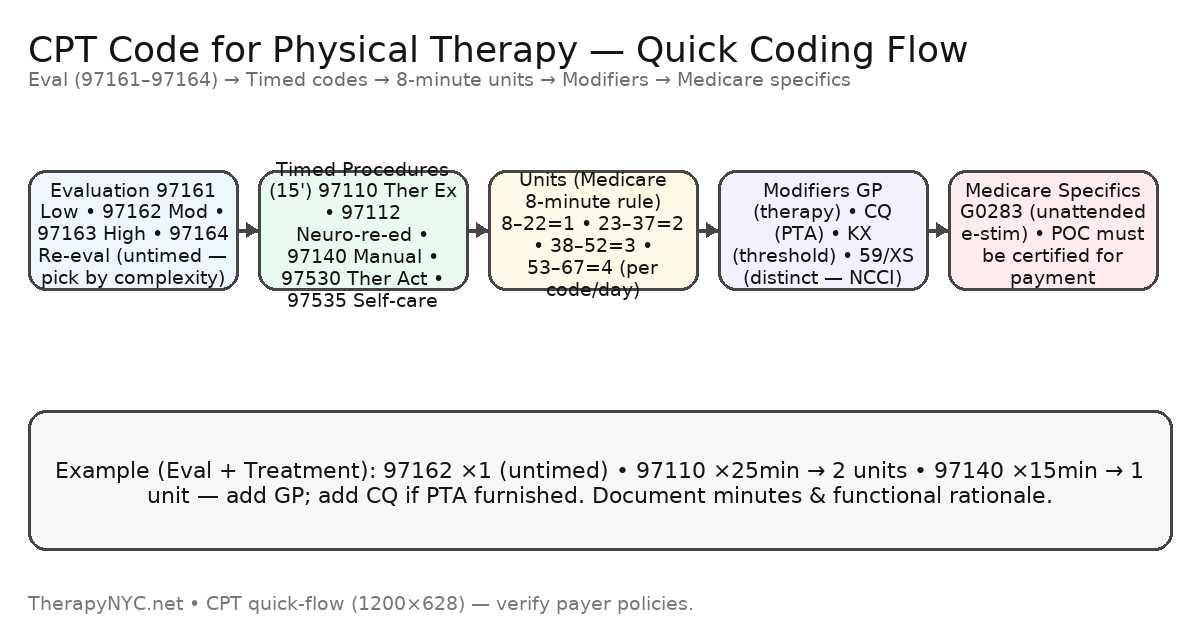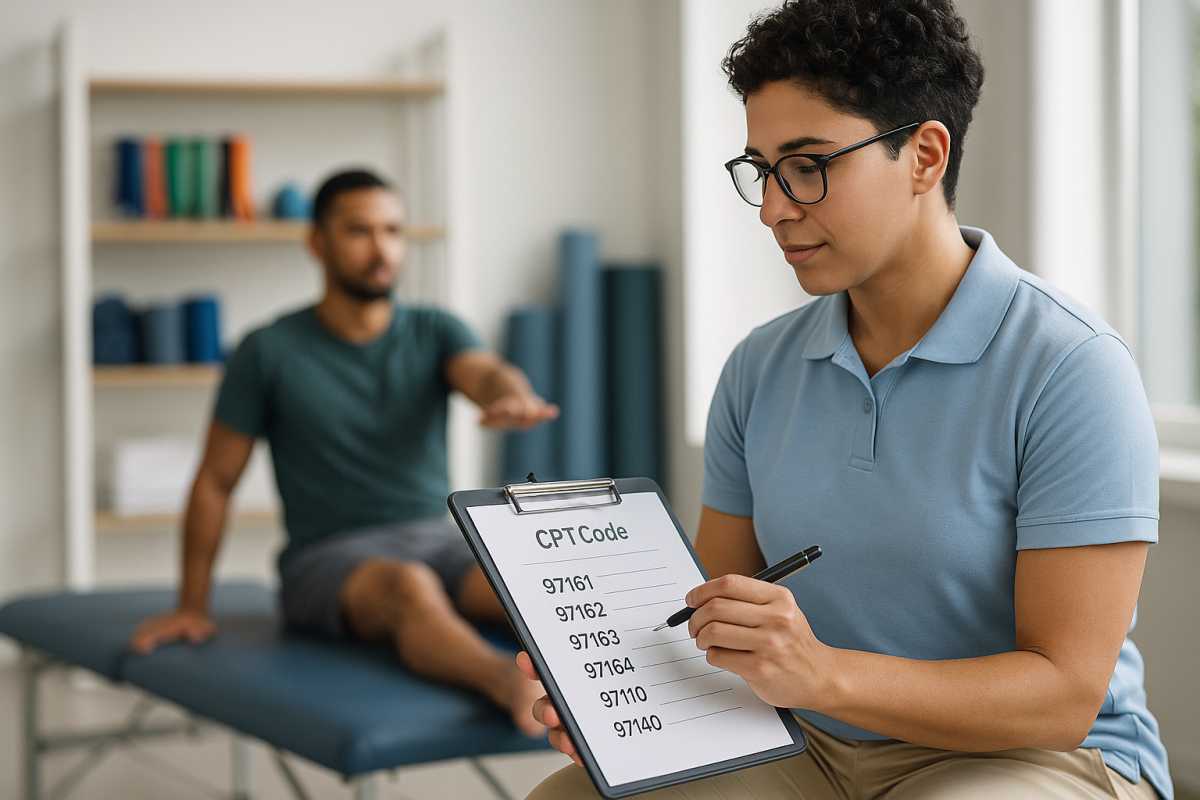Quick Take: CPT codes tell payers exactly what you did in a PT session. Getting them right affects coverage, denials, and cash flow. Below you’ll find the cpt code for physical therapy evaluation, the most common treatment codes, how timed units work, Medicare specifics, and a clean example of cpt code for physical therapy evaluation and treatment billed together.
Contents hide
What CPT Codes Do In PT (And Why They Matter)
“CPT” (Current Procedural Terminology) is the language payers read. In outpatient rehab, you’ll document what happened, then report the matching cpt codes for physical therapy on the claim—often with modifiers (e.g., GP, CQ) and units for timed services. Commercial plans and Medicaid follow variations of the same rules, but Medicare sets the tone for unit calculation and documentation expectations. For official definitions and Medicare therapy policy, see CMS’ therapy page. cms.gov
CPT Code For Physical Therapy Evaluation (97161–97164)
Evaluations are untimed and picked by complexity:
97161 – Low Complexity
97162 – Moderate Complexity
97163 – High Complexity
97164 – Re-evaluation
Complexity depends on history, exam elements, clinical presentation, and clinical decision-making—not minutes on the clock. APTA’s pocket guide breaks down the criteria that justify each evaluation level and the re-eval.
Tip: Document the factors that made the eval low/moderate/high (number of body regions, comorbidities affecting the plan, stability of the condition, etc.). That’s what reviewers look for when they verify your cpt for physical therapy choice.
Timed Vs. Untimed: The 8-Minute Rule In One Look
Most treatment procedures in PT are timed in 15-minute units. Medicare’s 8-minute rule is the standard many payers follow: you bill 1 unit of a timed code when you provide 8–22 minutes of that service, 2 units at 23–37 minutes, and so on—calculated per code and per day. CMS maintains the therapy policy in its manuals and online therapy pages.
Unit reference (per code, per day):
8–22 min = 1 unit · 23–37 = 2 · 38–52 = 3 · 53–67 = 4
Some commercial plans use a “total time” method across all timed codes in a visit. Always check payer policy; if they don’t say otherwise, assume the Medicare 8-minute approach.
The Codes You’ll Use Most (Cheat Sheet)
Below are common cpt codes for physical therapy you’ll see daily. Use the ones that best reflect what you actually did and document why.
Therapeutic Procedures (Timed, 15-min each)
97110 – Therapeutic exercise
97112 – Neuromuscular re-education
97140 – Manual therapy techniques
97530 – Therapeutic activities (functional tasks)
97535 – Self-care/home management training
97116 – Gait training
97113 – Aquatic therapy
97150 – Group therapeutic procedures (untimed)
Modalities
97032 – Electrical stimulation, attended (timed)
G0283 – Electrical stimulation, unattended (HCPCS; used by Medicare instead of 97014)
97012 – Mechanical traction
97035 – Ultrasound
97010 – Hot/cold packs (often bundled/non-payable; check payer)
Tests, Orthotics & More
97750 – Physical performance test/measurement (timed)
97760/97761/97763 – Orthotic/prosthetic management & training

Example: CPT Code For Physical Therapy Evaluation And Treatment
Scenario: New knee pain, 55-minute session.
97162 (moderate complexity eval) – 1 unit (untimed)
97110 therapeutic exercise – 25 minutes → 2 units
97140 manual therapy – 15 minutes → 1 unit
Claim lines (illustrative):
97162 – 1 unit · GP
97110 – 2 units · GP
97140 – 1 unit · GP
If any minutes were furnished by a PTA, append CQ on those lines per CMS assistant modifiers; if your payer requires it, use 59/XS to unbundle 97140 when edits apply (documentation must show it was a distinct service). See CMS therapy & NCCI policy.
Modifiers You’ll Actually Need
GP — Under a PT plan of care; required on therapy services.
CQ — Part or all of the service furnished by a PTA (Medicare applies a payment differential).
KX — When you exceed the annual therapy threshold and services remain medically necessary (Medicare).
59/XS — Distinct procedural service to bypass an NCCI edit when truly appropriate; documentation must support the separation (different region, different purpose). See payer guidance and NCCI edits page.
Medicare-Specific Nuances (That Cause Denials)
Unattended e-stim: For Medicare, bill G0283 instead of 97014. Many commercial payers follow suit—check your policy.
Plan Of Care: PT can start without a physician order, but Medicare payment requires a certified Plan of Care (physician/NP/PA signature) within required timelines. Your clinic usually routes this automatically.
Assistant Differential: If a PTA furnishes part of a service, append CQ and expect the statutory reduction.
Related Article: Do I Need A Referral For Physical Therapy?
Clean Documentation = Clean Claims
Match minutes to codes. Chart time next to each timed code.
Link every code to function. Why that manual technique? What activity goal did 97530 support?
Note complexity at eval. The reason you picked 97161/97162/97163 should be obvious from the note (history, tests, stability).
Mind NCCI edits. If you report codes that normally bundle (e.g., 97140 with 97530/97110), your note must show distinct work if you use 59/XS.
FAQs (The Way People Actually Ask)
Do I Need Referral For Physical Therapy Codes To Bill Insurance?
Coding doesn’t require a referral, but your payer might. Direct-access PT is allowed in every state in some form; coverage rules are separate. When in doubt, call your plan and ask if a referral/prior auth is needed for outpatient PT. (This article covers coding; it isn’t legal or billing advice.)
What’s The CPT Code For Physical Therapy Evaluation?
97161, 97162, 97163 for low/moderate/high complexity; 97164 for re-eval. Choose based on complexity—not minutes.
How Do I Pick Between 97110 And 97530?
97110 is for therapeutic exercise to improve strength, ROM, endurance, flexibility. 97530 is therapeutic activities—functional, dynamic tasks (lifting, carrying, squatting to a chair, etc.). Use the one that best matches the intervention and goal (and document the “why”).
Can I Bill Manual Therapy With An Eval On Day One?
Often yes, but NCCI edits may require 59/XS to show the manual therapy was distinct from the evaluation. Your note must prove it.
Copy-Ready Checklist For Your Team
Use the right evaluation code (97161–97163) + 97164 when you re-evaluate.
Apply the 8-minute rule for all timed procedures; calculate units per code.
Append GP on every therapy line; add CQ when a PTA furnished part/all of the service.
For Medicare: use G0283 (not 97014) for unattended e-stim; ensure POC certification.
Watch NCCI edits and document clearly if you’re using 59/XS.
Final Word
If you’re consistent with eval selection, unit math, and modifiers, your cpt for physical therapy will read cleanly to any payer—and you’ll spend less time fixing denials. Keep this page as a quick reference, and update your clinic template so every note naturally answers: what was done, why it was needed, how long it took, and how it moved the patient toward function.
